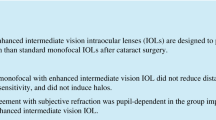Abstract
Purpose
To evaluate the early findings of new monofocal intraocular lens (Tecnis® Eyhance) in comparison with standard monofocal intraocular lens (Tecnis® 1-piece) in patients who underwent cataract surgery.
Methods
Sixty-four eyes of thirty-two patients (each intraocular lens model was implanted bilaterally in 16 patients) were included in this retrospective study. Preoperative and postoperative (at one month) manifest refraction, spherical equivalent (SE) values, monocular and binocular uncorrected distance visual acuity (UDVA), corrected distance visual acuity (CDVA), uncorrected intermediate visual acuity (UCIVA), distance-corrected intermediate visual acuity (DCIVA), distance-corrected near visual acuity (DCNVA), binocular defocus curve, photopic contrast-sensitivity, spectacle independence, photic phenomena, tolerance to residual refractive errors and complications were recorded.
Results
The mean monocular postoperative UDVA, CDVA, DCNVA, spherical equivalent and cylinder values were comparable between each group (p > 0.05). Monocular and binocular DCIVA and UCIVA were significantly higher in Tecnis® Eyhance group than Tecnis® 1-piece group (p = 0.033, p = 0.038, respectively). No statistically significant difference was detected between groups regarding the photopic contrast sensitivities for any spatial frequency (p > 0.05). Spectacle independence was significantly higher in Tecnis® Eyhance group than Tecnis® 1-piece group. Tecnis® Eyhance IOL revealed a good tolerance to unexpected residual refractive errors than Tecnis® 1-piece IOL.
Conclusion
Tecnis® Eyhance appears to be an effective option for both patients and surgeons regarding better intermediate visual acuities and more forgiving for residual refractive errors relative to the standard monofocal intraocular lenses. However, longer follow-up studies with larger group of patients are needed to evaluate the effectiveness of Tecnis® Eyhance intraocular lens.





Similar content being viewed by others
Availability of data and material
The datasets used and analyzed during the current study are available from the corresponding author on reasonable request.
References
Resnikoff S, Pascolini D, Etya’ale D, Kocur I, Pararajasegaram R, Pokharel GP et al (2004) Global data on visual impairment in the year of 2002. Bull World Health Organ 82(11):844–851
Jafarinasab MR, Feizi S, Baghi AR, Ziaie H, Yaseri M (2010) Aspheric versus spherical posterior chamber intraocular lenses. J Ophthalmic Vis Res 5(4):217–222
Tan QQ, Liao X, Tian J, Jia Lin, Lan CJ (2019) Visual performance and optical quality in eyes implanted with an aspheric or spherical monofocal intraocular lens: a systematic review with meta-analyses. Int J Clin Exp Med 12(3):2486–2494
Marcos S, Barbero S, Jimenez-Alfaro I (2005) Optical quality and depth-of-field of eyes implanted with spherical and aspheric intraocular lenses. J Refract Surg 21(3):223–235
Kohnen T (2008) Multifocal IOL technology: a successful step on the journey towards presbyopia treatment. J Cataract Refract Surg 34(12):2005
Alio JL, Plaza-Puche AB, Piñero DP, Amparo F, Rodríguez-Prats JL, Ayala MJ (2011) Quality of life evaluation after implantation of 2 multifocal intraocular lens models and a monofocal model. J Cataract Refract Surg 37(4):638–648
Sachdev GS, Sachdev M (2017) Optimizing outcomes with multifocal intraocular lenses. Indian J Ophthalmol 65(12):1294–1300
de Silva SR, Evans JR, Kirthi V, Ziaei M, Leyland M (2016) Multifocal versus monofocal intraocular lenses after cataract extraction. Cochrane Database Syst Rev 12:CD003169
Mencucci R, Cennamo M, Venturi D, Vignapiano R, Favuzza E (2020) Visual outcome, optical quality and patients’ satisfaction with a new monofocal intraocular lens, enhanced for intermediate vision: preliminary results. J Cataract Refract 46(3):378–387
de Vries NE, Webers CA, Touwslager WR, Bauer NJ, de Brabander J, Berendschot TT, Nuijts RM (2011) Dissatisfaction after implantation of multifocal intraocular lenses. J Cataract Refract Surg 37(5):859–865
Woodward MA, Randleman JB, Stulting RD (2009) Dissatisfaction after multifocal intraocular lens implantation. J Cataract Refract Surg 35(6):992–997
Carones F (2017) Residual astigmatism threshold and patient satisfaction with bifocal, trifocal, and extended range of vision intraocular lenses (IOLs). Open J Ophthalmol 7:1–7
Son HS, Kim SH, Auffarth GU, Choi CY (2019) Prospective comparative study tolerance of refractive errors after implantation of extended depth of focus and monofocal intraocular lenses with identical aspheric platform in Korean population. BMC Ophthalmol 19:187
Funding
The authors obtained no commercial provider for the investigation, authorship, and broadcasting of the study.
Author information
Authors and Affiliations
Contributions
UU conceived the idea. UU performed surgeries and HS collected the data. UU analyzed the data and HS wrote the manuscript. All authors approved the final version.
Corresponding author
Ethics declarations
Conflict of interest
The authors declare they have no financial conflict of interest related to this article.
Ethics approval and consent to participate
All procedures performed in studies involving human participants were in accordance with the ethical standards of Faculty of Medicine, Bakırcay University/Izmir. All procedures conformed to the tenets of the Declaration of Helsinki. Written informed consent was obtained from all individual participants included in the study.
Consent for participate and publication
The authors declare they have participated in this work, and they have reviewed the final version of the work, believe it represents valid work, and approve it for publication.
Additional information
Publisher's Note
Springer Nature remains neutral with regard to jurisdictional claims in published maps and institutional affiliations.
Rights and permissions
About this article
Cite this article
Unsal, U., Sabur, H. Comparison of new monofocal innovative and standard monofocal intraocular lens after phacoemulsification. Int Ophthalmol 41, 273–282 (2021). https://doi.org/10.1007/s10792-020-01579-y
Received:
Accepted:
Published:
Issue Date:
DOI: https://doi.org/10.1007/s10792-020-01579-y




